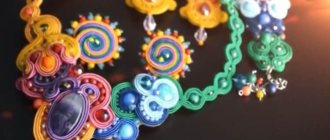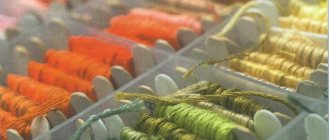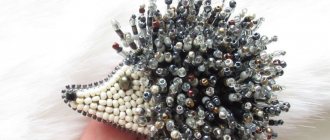Learning the basics of popular tatting techniques for beginners
Straight knot:
- In order to learn how to weave using the tatting technique, you need to learn how to weave a straight knot. To do this, take the thread and wind it around the fingers of your left hand, forming a ring. The thread on the left hand is called the leading thread.
- The shuttle must be held in the right hand, the thread coming from the shuttle in the right hand is called the leading one. The shuttle should be held between the thumb and index finger.
- Insert the shuttle under the leading thread, then pass the shuttle under the working thread, then over the working thread, tightening the knot. You will get a straight knot by tying from 4 to 9 straight knots, you can take the leading thread, press the knots and tighten them into a ring. You will get Pico Josephine. The video at the bottom of this article describes in detail and shows how to learn how to weave a straight knot.
Tatting elements:
- We learn to weave a reverse knot, to do this, wind the thread on the folded fingers of the left hand, connecting the thread into a ring, pass the shuttle over the working thread, bring the leading thread down from under the working thread into the ring, tighten the thread, you get a reverse knot. When 5-6 such knots are woven, they can be tightened and you will get a small ring, it is called a fly.
- Tatting knot: first weave a straight knot, then a reverse knot, this is called a tatting knot. If you weave several such knots and then tighten them, you get a ring.
- Picot: reverse knot, straight knot, tatting knot, weave 6 knots, in order to make a picot you need to make an indent, you get a picot eye.
Compound:
- In order to learn how to connect tatting elements, weave a ring, 3 tatting knots, a picot, 3 more tatting knots, 3 picots in a row, 3 tatting knots, a connecting small picot and 3 more tatting knots, tighten into a ring.
- Weave the second ring, for this purpose leave a small leg and weave it exactly the same as in the first case.
- Take the hook, insert it into the small picot, take the working thread and tighten to connect the two rings. Weave a third ring and connect in the same way.
how to find your ideal – Masters Fair
Tatting is an ancient type of knotted lace, which is made using threads, a shuttle (or needle) and a hook.
The history of tatting is very complicated and therefore tatting is called differently in different parts of the planet.
In Europe, shuttle lace making first appeared in Spain with the Moors, where it was called “okko”, that is, “eye”.
In Germany, this lace is called Schiffchenspitze (Schiffen Spitzen) - shuttle weaving or shuttle lace.
In England - tatting (tatin from "tat" - to weave lace) - woven lace. In France it is called the familiar word tatting.
As you understand from the title of the publication, we will talk about the main tool for weaving tatting - the shuttle. Shuttles come in different shapes, sizes and can be made from all sorts of materials.
Shuttles are divided into regular, binile, two-tier and for Celtic weaving.
Regular shuttles come in different sizes from 6.5 cm to 9-10 cm in length and from 1.8 cm to 2.9 cm in height.
Binary shuttles are long up to 8.5 cm and not high, no more than 1 cm in height. It is believed that this shape of the shuttle makes it possible to wind more thread with beads or beads.
In the photo with mother of pearl.
Two-tier shuttles have the appearance of a double shuttle. This shuttle is needed for weaving two-color lace without tearing off the thread.
The shuttles for Celtic weaving are very small - about 6 cm long and no more than 0.6 cm high. Celtic weaving is the interweaving of arcs and rings in the process of creating lace.
Shuttles are also made with a built-in hook and a long spout for easy connection of elements and untangling of knots.
There are shuttles with a removable handle for easy thread winding.
The main and most common form of shuttle is considered to be a shuttle made of two parts, ends tightly adjacent to each other, and a crossbar between them. For a beginning lacemaker, it is enough to purchase two shuttles.
Such a shuttle is made from plastic, wood, ceramics, metal (including silver), shell rock, and epoxy resin.
Shuttles can be decorated using any technique, depending on the material from which the shuttle is made. This is engraving, drawing, decoupage, cutting out a design and so on.
There is even an article at the Crafts Fair that describes how to make a shuttle from a mayonnaise bucket. I tried it. If you can’t buy them, then you get very normal shuttles for weaving.
It’s very easy to choose a shuttle for yourself - you need to try thousands of shuttles and choose your own (just kidding!).
Basic rules for choosing a shuttle for a beginner:
1. The size of the shuttle should not exceed the length of the index finger.
2. The shuttle should be light enough (for convenience) and smooth so that it does not catch the thread.
3. And most importantly, different people like completely different shuttles 
Here are examples of such shuttles from the Internet:
There are also flat shuttles for tatting. They are made from cardboard, leather, wood, plastic, bone.
Heidi Nakayama is considered the main shuttle researcher in the world.
She devoted 12 years to researching the history of American tatting shuttles, which resulted in the book Tatting shuttles of American collectors, consisting of 114 pages and a huge number of photographs.
And so, after reading the article or admiring the tatting lace, you decided to buy yourself a shuttle. Where can the average Russian consumer buy it?
You can look for shuttles like these in craft stores and at the Crafts Fair.
1. Industrial shuttles manufactured by Gamma. They are available in plastic and metal with a replaceable bobbin. There you can sometimes find the “Prym” shuttle for weaving lace using the tatting technique.
2. Pony hook with built-in hook and replaceable bobbin.
3. You can buy these plastic shuttles in Russian stores or order them in China.
4. A variety of wooden shuttles.
5. Metal shuttles.
6. Bone shuttle or pendant shuttle.
7. Tatting shuttles from Clover.
8. Decorated shuttles.
Very often, lacemakers from all over the world buy all types of shuttles available for purchase. Sometimes the desire to weave with a variety of shuttles develops into collecting - a process no less exciting than tatting lace itself.
And with such diversity, collecting shuttles can become a wonderful hobby.
Below is a photo of the beginning(!) of collecting shuttles by a foreign lacemaker.
Best regards, Inna.
www.livemaster.ru
How to learn to weave tatting with a needle with a diagram and description
To learn how to weave lace with a needle, you need a pattern, thread and a long needle.
K – 5p 5p 5p 5p, the diagram reads like this, the ring consists of 5 tatting knots, picot, 5 tatting knots, picot and so on.
- Insert the thread into a long needle, leaving about 40 cm of thread on the right and start weaving knots in the same way as with a shuttle: a forward knot, a reverse knot, you get a tatting knot, then make an indent, you get a picot, continue according to the pattern, making the same picots, when finished, remove from the needle and tighten it into the ring, fix it.
- Weave an arc according to the pattern: k - 5p 5, tatting 5 knots, picot and 5 tatting knots, remove from the needle, you will get an arc, fasten, turn over onto your face and continue weaving.
- Weave 5 tatting knots, a connecting picot, take a hook, insert it into the picot, pull out the thread and put it on a needle. The first element is ready, continue weaving to ultimately get a beautiful lace.
We knit a lace collar.
This is a simple pattern. I have two parts of knitting a collar. The first part can be used not only for a collar, but also sewn onto a tablecloth, on the hem of a skirt, or on the edges of a blouse. Just take a needle and thinner thread. Everything I have is thick so that it can be seen more clearly.
- This is the first part.
We knit the second part.
Let's weave lace earrings with a spring-summer mood
Materials: shuttle, scissors, threads of light green, soft pink and white colors, to attach ready-made earrings you will need round-nose pliers, tweezers, to secure the knots you can use colorless nail polish and as accessories you need two rings, two earrings, two pins and decorative soft pink glass beads.
- Take a shuttle with a thread, make a tatting knot and an indent, a picot, about 2 mm, continue weaving, alternating picots, a tatting knot until there are 10 picots in the ring, tie a knot at the end, make an indent of 6 mm and start weaving the next one ring, make exactly the same as in the first case, ring with 10 picots.
- It is necessary to weave 18 such rings, you can weave more, you can weave less, it depends on the thickness of the thread. The length of the product will be 12 cm when stretched. Cut off the knot and secure with varnish, let dry. Take the shift, place a bead on it at a right angle, bend the shift and then use pliers to make a bow.
- Then take the ring, hold the ring with one pair of tweezers, and with the other bend the bow to the side, put three elements knitted from pink, white, green thread onto this bow. Next, put on the bead and connect the ring as before.
- Take the second ring and put on the pink, white, green one in the same order and then put a bead on the same ring, and put an earring on the ring with a pin with a bead, bend the bow at the pin so that it is possible to put on the earring and return this bow back .
The result is unusually delicate and delightful earrings that will decorate the spring-summer look of any fashionista.
This technique is very economical, very little thread is consumed, and all the materials and tools necessary for weaving fit into a small cosmetic bag.
Tatting for beginners step-by-step master class video and photos
Tatting for Beginners Basic Techniques and Projects
Tatting for beginners - made products that look excellent and feminine on young girls and women. This is a technique of weaving from knots, which makes it possible to create charming lace, marked by an extraordinary ornament of interweaving arcs and rings.
This type of creativity, tatting with a needle, is economical and small-sized - everything you need takes up little space in your cosmetic bag. The described art is used to create elements of clothing, napkins, decorations - it all depends on the imagination of the needlewoman.
The described technology is quite often combined with other types of creativity:
- crocheting or knitting;
- macrame;
- embroidery
Wicker items decorated with pebbles have a beautiful and extravagant look.
Video course on tatting with a needle for beginners
Working material
To create such divine beauty in tatting with a needle for beginners, you and I need to prepare material that will be useful during the course of action:
- Shuttles. Tatting is usually done using shuttles.
Such tools have their own priorities:
- nodules are performed using any method;
- the thread does not unwind.










